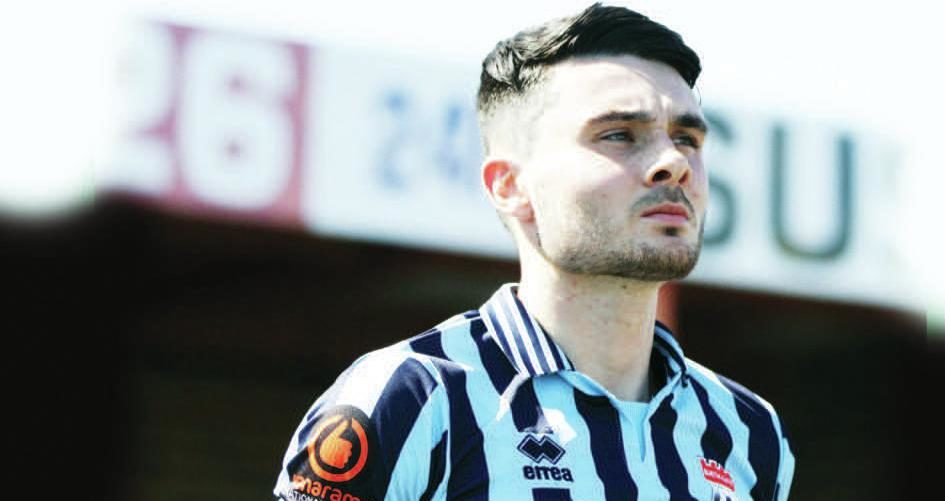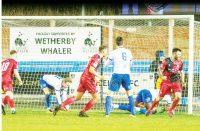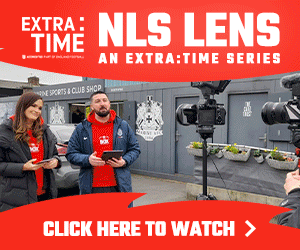Some say, why do we need all this regulation in football. It’s just a game, isn’t it? If you’re one of those people, eBay will sell you some replacement marbles.
This year in Non-League we’ve seen fireworks thrown into grounds, scary levels of misbehaviour on and off the field, and wholesale abuse randomly targeted. Most recently, Bath City‘s Alex Fletcher was seriously injured when he collided with pitch perimeter barriers. Get well soon Alex.
There is a big difference. Fireworks and violence are deliberate actions. Alex Fletcher’s injury was an accident. However, both fall under the category of risk.
The reality is that football is a risky business, and where there’s a risk, there’s usually a claim. In the current climate, clubs are most likely to be left to face facing any claims that do arise.
The issue, therefore, is how far should semi-professional clubs with limited resources be reasonably expected to go to make their stadia safe for every participant, players, fans, officials, staff, and volunteers?
Perimeters
Let’s look at perimeter barriers. In the NLS many grounds still have the old concrete posts with metal rails. Others have more modern, metal barrier systems that negate the use for concrete posts.
At Step 4 and above, ground grading criteria require barriers to be infilled, ideally with advertising boards, to partly off-set the cost of the infill. The specification of pitch perimeters and the materials to be used, are clearly set down in the rules.
Providing a club is compliant with those rules, in the event of an incident similar to that which befell Alex Fletcher, they should be safe from prosecution. A club that is non-compliant in this regard might not be so fortunate.
There have been suggestions that clubs should install cushioned covers around concrete posts. A fair suggestion, but one that inevitably could carry a hefty bill, such is the wide variation in shapes and sizes across the NLS, especially at Steps 4-6.
Further, the issue of perimeter barriers cannot be considered in isolation as there are a number of new risk-related initiatives coming down the line, each adding to clubs’ running costs with limited scope for offset the additional costs.


Medical
The medical qualifications for football ranging from emergency football first aid through to qualifications to support those working in the game have been updated to ensure the best emergency care for players
In the new year, all NLS clubs’ medical staff have to achieve the new level of qualification for the tier of the game at which they play. The cost of these courses is not excessive and leagues will be exploring whether the costs can be part subsidised, but it is a non-budgeted cost nonetheless, plus time off work, travel costs and so on.
Safeguarding
Any club with players aged under 17 have legal and binding Safeguarding obligations. Those requirements are also being tightened with a review underway across a sample of clubs to find out what practice is in place.
As with medical regulations, the target is a tiered approach to NLS safeguarding standards with the most appropriate compliance and support model.
The point here is not whether we need these interventions, because we do. No-one should ever put someone’s health or safety at risk simply to make money. Neither is the issue whether we need all these changes now. Not implementing change puts someone at risk.
It’s all about putting measures in place that are proportionate. Everyone has a right to expect Non-League football to be a safe environment, but is it possible to cover every eventuality? Sadly, bad things happen to good people and accidents, like mistakes, do happen.
Then there’s the law of Unintended Consequences. We don’t ever want to reach a position whereby, for example, a referee refuses to play an NLS game because one of the sides involves has not got the required medical qualifications. Worse, a fan or player is injured because, ultimately, the club has failed to meet its ground and facilities obligations.
Who pays?
Like any large organisation, The FA is risk-averse, and for good reason. We live in an age whereby people don’t take responsibility for their actions but instead blame someone, or anyone, else.
Lawyers then get involved, and they always look for the party with the deepest pockets as their best chance of securing a payday for themselves and the clients. So, if you can’t sue the FA, the next best thing is to try leagues and clubs. Most leagues are not-for-profit bodies, which leaves clubs holding the baby, so to speak. Clubs are facing escalating running costs, and “The FA should pay” is an understandable but simplistic response.
Uncertain future
Ideally, as the world goes to hell in a handcart, Non-League football would be an escape from the day-to-day horrors facing us all. However, as you’re now hopefully seeing, clubs and leagues (even the FA) are not immune from the woes of the world, to which can be added extra levels of administration, regulation, and cost.
I worry that we could easily reach the point whereby clubs fold simply because the risks of operating are too high for owners, directors, and fan groups to fund. The new NLS strategy that is being developed aims to address some of these challenges but will only work if embraced by clubs and fans. It is potentially a game changer but, like anything in life, won’t be easy.
The next time someone accuses your club of a lack of ambition in failing to keep up with the wages arms-race that exists at every level of the game, remember this: Success at Non-League level isn’t winning cups or leagues. It is operating sustainably which providing safe environments for players, volunteers and fans.
Only a game of football? Stroll on.
























